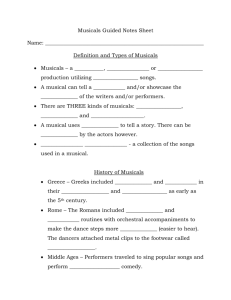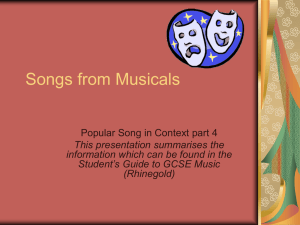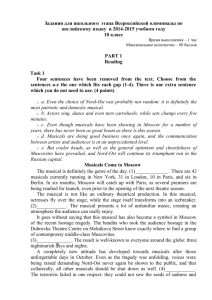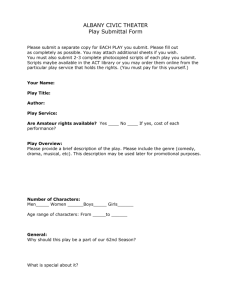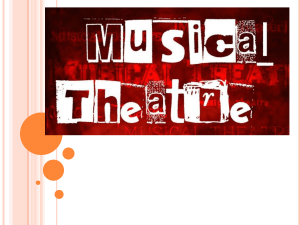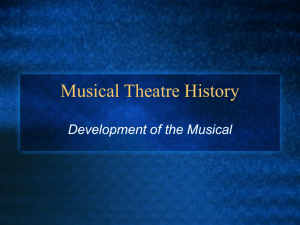Musicals * - Varieur Film Studies
advertisement
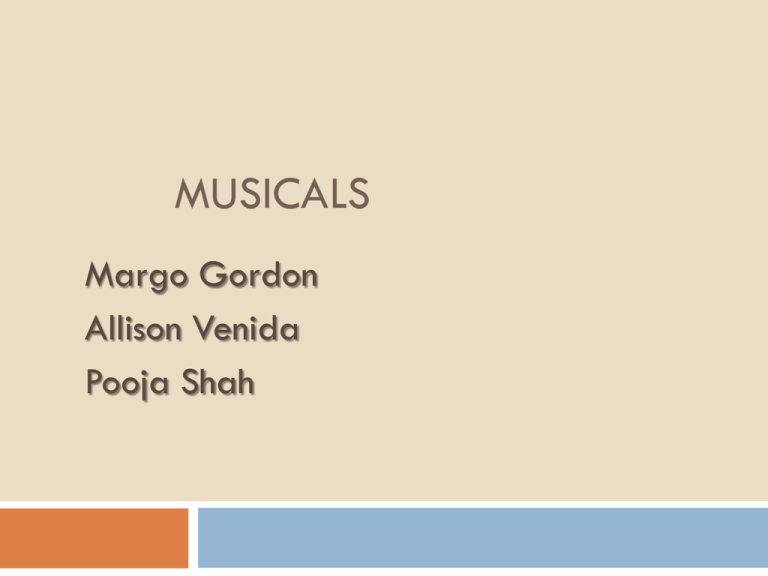
MUSICALS Margo Gordon Allison Venida Pooja Shah History of Musicals Illustrations of show musical begin with America’s first talkies First Musical: Jazz Singer (1927) Musicals from 1930’s focus more on dancing than singing. ( there was a combination of music, singing, dancing, and spoken dialogue) The system of recording and projecting sound took 25 years to perfect. 1940’s: Conventional musicals hinted at the postwar malaise Comedy had a bitter age Personal relationships started to be portrayed as difficult to maintain between two creative people (mostly shown in Backstage storylines) 1950’s: -The pinnacle of musicals. -Celebrated imagery over reality. - This was the time when the majority of the audience wanted to watch musicals and felt as if they could relate. - Examples: An American in Paris, Singin’ in the Rain, The Band Wagon 1960’s The 1930’s to 1960’s were known to be the golden age for Musicals in the Western world Arthur Freed, a producer from MGM made technicolor remakes in order to transition into a newer kind of musicals. Rock and Roll was a music style that had an impact on the Musicals as well. The Sound of Music and Mary Poppins were two of the most famous during that time. 1970’s In the 1970s, film culture and the changing demographics of moviegoers placed greater emphasis on gritty realism, while the pure entertainment and theatricality of classical era Hollywood musicals was seen as old-fashioned. Hays Code was finally terminated, and so more options to express in musicals. 1980’s- Present Musicals are less popular because musical tastes have become more diversified than they were back then, and there are more listening choices. Back then, there were fewer genres and sub-genres of music to chose from, and people were more likely to listen to the same music. Because of that, it's harder to market a new musical that would have widespread (aka profitable) Iconography In most musicals, it is expected that the props nearby would be used in the following performance. Usually there is a stage which helps transition many of the songs that will be performed. The setting is also a part of iconography as it is most times a set in which it is easy to perform with. Mood The moods for the majority of musicals were more or less happy. Accoriding to the time period of the musicals, some of them were grim (ex: during the Depression) They were meant to make the moods lighter which is the reason subgenres of these include Fantasy and Children’s Musicals which make reality seem less harsh and more fun. Plot Backstage Musical: a narrative centering on singers and dancerse (ex: Singin’ in the Rain) Revolved around a promising young performer searching for her big-show business break or a talented singer/ dancer protagonist pressured by another source such as a love interest. Straight Musical: where people may sing and dance in situations of everyday life.( usually romantic comedies) Use songs to express fears, longings, and joys. * Traditional Musicals used romantic comedies for their narrative template. Integrated Musicals Freed the genre from the Broadway setting Assimilated dancing and singing with conventional spoken dramatic action: characters now could burst out into a song/dance for any situation. Sometimes these songs are delivered to another character, or are inward like a soliloquy, or directed at the viewer. Hollywood Musicls: Celebrate American ideals Examples 1) Ambition is Rewarded 2) Romance ends Happily 3) High ideals are justified Cinematic Style Musicals can be brightly lit to set off cheerful costumes and sets and to keep the choreography of the dance numbers clearly visible. In musicals , the lightning that are usually used are bright and high-key. For bright musicals, the shots will be sharply focused. The composition is wide shots that play big, and are open and uncluttered. Musicals utilize carefully choreographed camera moves to go with the choreographed dances Character Type Characters were generally happy and their singing or dancing helped emphasize this as well. In later Musicals such as Meet me in St. Loius showed that anyone could sing or dance (portrayed characters from the middle-class) Usually had a conflict to pursue, and many times it was in the show business itself, making the songs transition more smoothly. Costumes and Symbols Costumes are generally cheerful During the Depression, however, there were symbols that made the entire film express the sadness. Impact on Society During the Depression, there were musicals which were tragic and musicals such as “Pennies from Heaven” which evoked the grim atmopshere of Depression and characters lip-synced to recordings from that era. Grim realities of life Actors/ Directors Busby Berkeley: one of the first choreographers who believed that having the dancing and singing on screen would be more interesting than the one on stage. His ballets were purely cinematic creation. Camera was a huge part of choreography. Awards Film in the 1940’s This was the War and Post-War years The world was headed toward rearmament and warfare in the early to mid-1940s, and the movie industry, like every other aspect of life, responded to the national war effort by making movies The US government's Office of War Information (OWI), formed in 1942, served as an important propaganda agency during World War II, and coordinated its efforts with the film industry to record and photograph the nation's war-time activities. The 40s also offered escapist entertainment, reassurance, and patriotic themes Although it was mainly black and white films, technicolor became more and more popular during the decade. Hollywood enjoyed its greatest financial year in history in 1946. An all-time peak in annual box-office receipts, at $4.5 billion, was achieved The introduction of Film Noir was also introduced during this time. The film noir 'genre' reflected the way Hollywood felt as it faced its greatest challenges during the war and postwar periods - darker and more cynical. Gangster Movies also had their revival Animated films cartoon characters Bugs Bunny, Tom and Jerry, Woody Woodpecker, Mighty Mouse, and Casper (among many others) made their film debuts in the 40s decade. Some Problems During the 1940s the coming of television forcing potential moviegoers to remain at home blacklisting and McCarthyism a 1945 studio labor union strike that raised salaries 25% for studio employees a short-lived 75% import duty, from 1947-1948, that restricted the import of all US films into the UK the gradual decline of theatre-attending audiences inflation that raised film production costs anti-trust rulings by the US government against the studios
